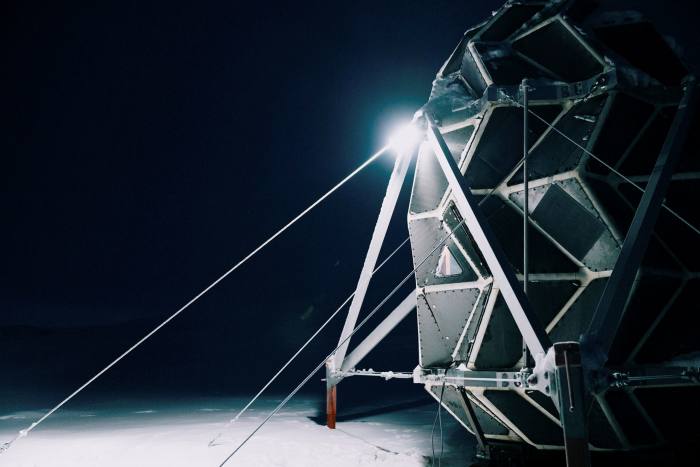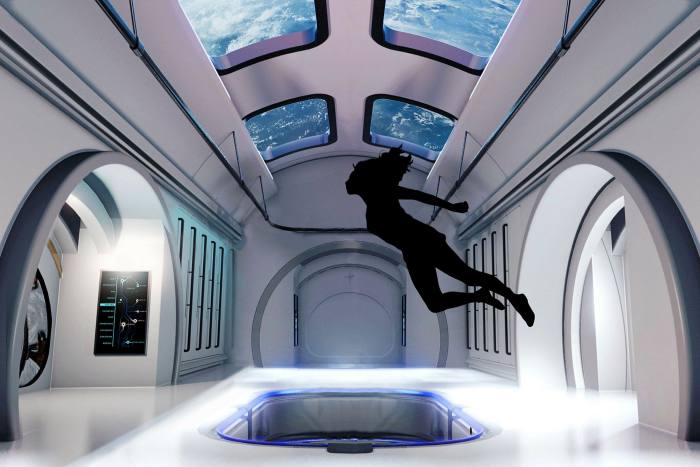Space, the final frontier of housebuilding
When architect Sebastian Aristotelis arrived in Greenland late last year, he was toting a tent of his own design. The co-founder of the Copenhagen-based practice Saga had devised an origami-inspired structure, one he describes as a “black pineapple in an icy environment”. He was due to spend two months living in it with colleague Karl-Johan Sorensen for an unusual experiment.
This was no prototype aimed at extreme sports enthusiasts, however, but far more otherworldly: Aristotelis is one of the world’s only space architects and this was a mock-up for a building on the Moon and beyond.
Frontier-chasing billionaires such as SpaceX’s Elon Musk or Jeff Bezos with Blue Origin have renewed interest in an endeavour that had fallen from favour since Nasa’s glory days, when the cold war was waged by proxy in the even colder reaches of space. Much attention is now being paid to making rockets and shuttles more sustainable, affordable and profitable for these private companies.
What, though, of the permanent structures that they predict? Whether hotels set in orbit around the Earth like Orbital Assembly’s 280-guest Voyager Station, planned to open in 2027, or the colonisation of Mars? There are now courses in such construction — the University of Houston offers an MSc in space architecture, for instance — but only a handful of people are pursuing it.

Aristotelis is one of them, and his tent allows him to collect data useful for replicating such structures in space. Greenland’s sometimes -50C temperatures might not descend to deep space levels but do offer the closest Earth-bound analogue. Such extremes are troublesome for the building’s seams, which need a material that remains flexible even when super-chilled.
The unlikely solution came from an ice-cream cake factory, where the material used for its production conveyor belts, a nylon-reinforced rubber, could be adapted for his needs.
Growing up in central Copenhagen, Aristotelis studied architecture at college but always with an eye for the stars. “I tried to tell people that I wanted to be a space architect, and they were being nice, but I could see in their heads they were thinking that this guy is completely crazy,” he says. “Every assignment at university, I’d always try to make it about space.”
He petitioned for his urban planning assignment to focus on a future Mars colony, only to be denied because there was no specific site he could visit to collect data. Undeterred, Aristotelis found a desert in Jordan that mimicked the red-soiled surface of Mars, grabbed a sleeping bag and tent, and spent two weeks there alone to simulate a reconnaissance mission. “I got the highest grade possible,” he says.

He then took a postgraduate course with the International Space University on its Delft campus three years ago. “I learnt 70 per cent of what I know about space in those nine weeks,” he says.
The trip to Greenland last year was the culmination of 18 months of fundraising, much of it crowdsourced. Its Arctic terrain mimics space for reasons other than extreme cold, he explains: the isolation and the monotonous landscape, for example.
Palpable peril was important too. “You cannot simulate stress — it’s a real physiological phenomenon that happens inside the body,” Aristotelis says. “As your hormone levels rise, you can make bad decisions.”
The Arctic has periods of near- constant darkness, much like in space, and such environments are taxing on the human body. Saga’s tent ceiling included a custom lighting system that mimicked the sun rising and setting.
“We didn’t have to take sleep medication, and we didn’t lose a sense of time — we woke up with a beautiful sunrise, and would go down to prepare breakfast, boil a cup of coffee,” Aristotelis says. There are potential applications for such technology here on Earth too, especially in high-density cities with small, light-poor apartments. These terrestrial solutions are another potential revenue stream, says Aristotelis.
“The journey is like a pearl necklace, where each pearl is a small success — the overall vision is so crazy, you need some of them.”


Brent Sherwood wouldn’t be so dismissive of his vision. Sherwood is senior vice-president of advanced development programmes for Blue Origin, the Bezos-founded company, which, in October, announced plans for Orbital Reef, a commercial space station that will include accommodation.
He has worked in the field since the 1980s and helped set up a committee on space architecture at the American Institute of Aeronautics and Astronautics. He also edited Out of This World: The New Field of Space Architecture, published in 2009. Brent calls out Aristotelis as a talent. “He’s not crazy. He’s very committed and quite innovative.”
Sherwood adds that many of the concepts mooted for interplanetary development aren’t viable — think of the crystalline domes common in set designs from Doctor Who to the 1970s TV show Space: 1999. The atmospheric pressure of a vacuum forces structures in such locations to act more like high-pressure balloons, he says, and these glorified greenhouses would shatter. Their transparency is also misplaced, as the only known way to shield humans from harmful radiation beyond the Earth’s atmosphere is via mass.

Moon homes, for example, will need to be shielded by thick walls rather than glass windows. “It doesn’t mean troglodytic living — you can design it so it’s not oppressive. Think about a Gothic cathedral, which is mostly stone but has a bit of glass high up in its vaulted space.”
Buildings on the Moon and on Mars could deploy some of the same technology, but much of the design would need to be localised. Atmospheric differences are one reason, but the different dusts on those worlds are more impactful. Moon dust is abrasive and can cause silicosis when it reaches the lungs; the danger in Mars dust is its high level of toxic perchlorates.
“In space, whether the environment has weather, and what the dust is like, that will make the architecture in different places somewhat unique,” says Sherwood.


However, successful space construction is not simply down to solving technical conundrums such as these. Dr Sheryl Bishop is a social psychologist looking at the impact of outer space on how astronauts think and feel. She has participated in experiments similar to the one Saga’s Aristotelis conducted in Greenland, as well as studying space missions.
Early rockets didn’t include windows because engineers considered them unnecessary, she says; it was only when astronauts protested that they wanted to look down at Earth that they relented. On long-haul flights such windows are functionless as our eyes struggle to perceive deep space. Better instead, Bishop suggests, for the interior of a rocket to be covered in digital panels in lieu of windows that can offer stimulation at the push of a button; the same is true of a home built on a planet with barely any atmosphere.
She has some interior design ideas too, explaining that humans thrive best in interiors that are cognitively complex, but not complicated. A stark white room with jumbled wires everywhere is complicated and strains the brain — but a room that stimulates through novelty and surprise is complex by design. Earth is innately complex and replicating it in some way in space buildings will be vital for astronauts’ wellbeing.
The key, Bishop says, is down to fractals; research has shown it’s the fractal elements of nature that particularly soothe us. “The walls don’t have to be featureless. What if we put fractal patterns on them, or created textiles that were fractal in nature?”
Such considerations will be front of mind for Sebastian Aristotelis the next time he isolates in a new iteration of his space pod.
“Half a year ago, I said I would not do a simulation any time soon, but I’m trying to sneak in maybe a weekend inside the next habitat,” he says. “But I can feel the anxiety and the tingling building up.” Then again, that might just be the cold.
Follow @FTProperty on Twitter or @ft_houseandhome on Instagram to find out about our latest stories first